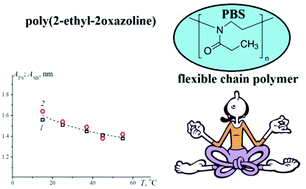Conformational properties of biocompatible poly(2-ethyl-2-oxazoline)s in phosphate buffered saline†
Abstract
Inspired by the increasing popularity of poly(2-ethyl-2-oxazoline) (PEtOx) for biomedical applications, this study reports the complete and thorough solution analysis of the homologous series of biocompatible PEtOx samples in a very broad range of molecular weights ranging from 11.2 × 103 g mol−1 up to 260 × 103 g mol−1. The main focus of the research was on the determination of the conformational properties of PEtOx macromolecules at a temperature of 37 °C in phosphate buffered saline (PBS) simulating the parameters of physiological media. The polymers were studied in PBS solutions by analytical ultracentrifugation, dynamic light scattering (DLS), translational diffusion, and intrinsic viscosity measurements in a temperature range from 15 °C up to 72 °C. The complete set of Kuhn–Mark–Houwink–Sakurada scaling relationships revealed linear trends over the whole range of the studied molar masses, while the determined scaling indices at 37 °C correspond to the coil conformation in a thermodynamically good solvent ([η] = 0.045 × M0.62, s0 = 0.010 × M0.46 and D0 = 1750 × M−0.54). Based on the intrinsic viscosity values (most sensitive characteristic to the size variations of polymer coils, [η] ∼ r3), it was demonstrated that PEtOx macromolecules in PBS solutions undergo a transition from swollen polymer coils with gradual deterioration of thermodynamic quality of solutions within the temperature range of 15–45 °C, reaching θ-conditions at 55 °C with further precipitation at 62–72 °C. Also, to the best of our knowledge, the conformational parameters (equilibrium rigidity/the Kuhn segment length and the diameter of the polymer chain) of PEtOx macromolecules were evaluated under physiological conditions for the first time and constitute A = 1.8 ± 0.3 nm and d = 0.7 ± 0.4 nm. These equilibrium rigidity values classify PEtOx as a flexible macromolecule with rigidity similar to that of poly(ethylene glycol). For the first time, we were able to demonstrate a direct influence of thermosensitivity on the rigidity of the biocompatible polymer: PEtOx. The Kuhn segment length is undoubtedly decreasing when approaching the LCST.



 Please wait while we load your content...
Please wait while we load your content...